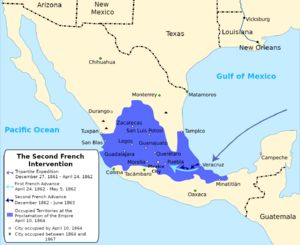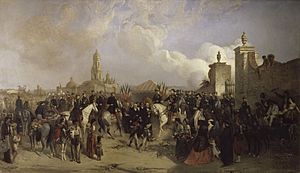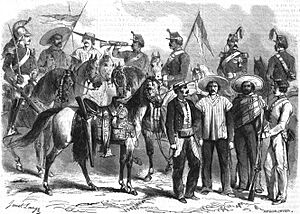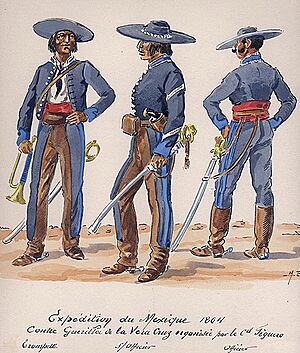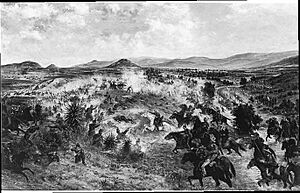Second French intervention in Mexico facts for kids
Quick facts for kids Second French intervention in Mexico |
|||||||
|---|---|---|---|---|---|---|---|
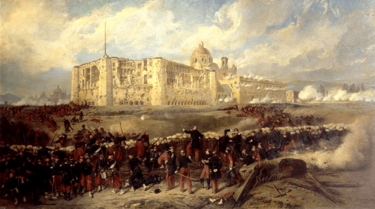 French assault during the Second Battle of Puebla |
|||||||
|
|||||||
| Belligerents | |||||||
|
|
||||||
| Commanders and leaders | |||||||
|
|
||||||
| Strength | |||||||
| Casualties and losses | |||||||
|
Details
Mexican Empire: 5,671 killed 2,159 wounded 4,379 captured Belgium: 573 dead
|
||||||
The Second French Intervention in Mexico (also called the Franco-Mexican War) was a time when France invaded Mexico. This happened between 1861 and 1867. The French Empire, led by Napoleon III, wanted to make Mexico pay back its debts. Great Britain and Spain also wanted their money back.
Mexican conservatives, who had lost a civil war against the liberal government of Benito Juárez, supported the French invasion. They hoped France would help them set up a monarchy (a country ruled by a king or emperor) in Mexico. Napoleon III liked this idea because he wanted France to have more power in the Americas.
Even though the French took over Mexico City and set up Archduke Maximilian as emperor, his new empire didn't last long. The United States, which finished its own Civil War in 1865, started helping the Mexican Republicans. In 1866, Napoleon III decided to pull his troops out of Mexico. This made Maximilian's empire fall apart quickly. Maximilian and two Mexican generals were executed on June 19, 1867. This ended a very important period in Mexican history.
This invasion happened right after Mexico's Reform War, a civil war. The French arrival allowed Mexican conservatives to fight against President Juárez's liberal reforms again. The Catholic Church, many wealthy Mexicans, and some Native Mexican communities welcomed the French. They helped install Maximilian of Habsburg as Emperor of Mexico. However, Emperor Maximilian turned out to be quite liberal himself. He even continued some of Juárez's reforms. Some liberal generals, like Santiago Vidaurri, even joined the Empire.
The French army landed in 1861, hoping to quickly capture Mexico City. But Mexican Republican forces defeated them at the Battle of Puebla on May 5, 1862. This famous victory, known as Cinco de Mayo, delayed the French capture of the capital for a year. The French and Mexican Imperial Army did take control of much of Mexico. However, Republican fighters kept up a strong guerrilla war. President Juárez never left Mexican territory.
The war was costing France a lot of soldiers and money. At the same time, Prussia was becoming very powerful in Europe. This made France focus more on European matters. The United States, even with its own Civil War, still recognized Juárez's government. After the US Civil War ended in 1865, the United States started sending supplies to the Mexican Republicans. The US government also reminded France about the Monroe Doctrine. This rule said that European powers should not interfere in the Americas. Facing pressure, the French army began leaving Mexico in 1866. The Second Mexican Empire collapsed in 1867.
Contents
History of the Conflict
Why the Invasion Happened
Mexican monarchists had long dreamed of bringing back a monarchy to Mexico. Mexico had been a monarchy when it first became independent from Spain in 1821, under Emperor Agustín I. Mexican conservatives asked French Emperor Napoleon III for help.
The United States was busy with its own American Civil War (1861–1865). This meant it couldn't stop France from interfering in Mexico, even though it went against the Monroe Doctrine. Napoleon III thought a Mexican monarchy, supported by France, would help France gain power in Mexico and Latin America.
In 1861, Mexican President Benito Juárez decided to pause payments on foreign debts. This meant Mexico wouldn't pay back loans for two years. France, the United Kingdom, and Spain then agreed to work together to get their money back. On December 8, 1861, their navies landed troops at Veracruz, a port city.
The British soon realized that France wanted to take over Mexico, not just collect debts. So, the United Kingdom made a deal with Mexico and left. Spain also left shortly after. This left France to invade alone, which led to the creation of the Second Mexican Empire (1864–1867). France, Britain, Belgium, Austria, and Spain recognized this new monarchy. But the United States refused, seeing it as a violation of the Monroe Doctrine.
Napoleon III wanted more than just debt repayment. He wanted to change Mexico's government. Mexican exiles convinced him to help set up a European prince as Mexico's emperor. Napoleon III was worried about the US opposing this, but the US Civil War made him less concerned. Juárez's debt pause gave him an excuse to intervene. Napoleon III also wanted to ensure France could access Mexican resources, especially silver. He also hoped to make Mexico a French ally in the Americas to limit the growing power of the United States.
Early Multinational Intervention
A group of countries, Spain, Great Britain, and France, formed the Tripartite Expedition. They wanted to force President Benito Juárez's government to pay back its debts. Juárez had stopped payments on Mexican government bonds.
On December 14, 1861, Spanish ships took control of Mexico's main port, Veracruz. French and British forces arrived on January 7, 1862. Spanish General Juan Prim announced that the allies were not there to conquer Mexico or impose a new government. He said they only wanted to discuss their claims for damages.
On January 14, 1862, the countries presented their demands to Mexico City. Mexican Foreign Minister Manuel Doblado invited the foreign leaders to a meeting in Orizaba. He asked them to bring only two thousand troops. Most of the troops stayed in Veracruz. But negotiations led to an agreement on January 23. This agreement allowed the forces to move inland for a conference in Orizaba. It also officially recognized Juárez's government and Mexico's independence.
The French Invasion Begins
On April 9, 1862, the agreements in Orizaba broke down. France made it clear it planned to invade Mexico and interfere with its government. This went against earlier treaties. The British told the Mexican government they would leave. They made a deal with Mexico to settle their debts. On April 11, Minister Doblado warned France that its actions would lead to war.
Some Mexican officers supported the French from the start. On April 16, 1862, the French asked Mexicans to join them in setting up a new government. On April 17, Mexican general Juan Almonte, who had been a foreign minister for the conservative government, supported the French. He told the Mexican people that the French had good intentions.
Fighting broke out between the French invaders and Mexican defenders. The French defeated a small Mexican force and captured Orizaba. Mexican Generals Porfirio Díaz and Ignacio Zaragoza retreated. Almonte tried to gather Mexican supporters for the French. The town of Orizaba, Veracruz, and Isla del Carmen joined him. On April 28, 1862, French forces marched towards Puebla.
On May 5, 1862, Mexican forces led by Ignacio Zaragoza and Porfirio Díaz won a big victory. They defeated the French at the Battle of Puebla. The French were trying to climb a hill to attack the city's defenses. The French retreated to Orizaba to wait for more soldiers. Mexico's victory stopped the French from taking Mexico City for a year. In Mexico, Cinco de Mayo is a day to celebrate Mexican pride.
Conservative Mexican Generals tried to join the French. Mexican Republican forces lost battles near Orizaba.
After the French defeat at Puebla in May 1862, Napoleon III sent 30,000 more troops in July. General Élie Frédéric Forey led these new forces. The French Emperor told Forey to work with Mexican supporters. Their goal was to set up a new government friendly to France. They also wanted to stop the United States from becoming too powerful in the Americas. Forey reached Orizaba on October 24, 1862. He began planning another attack on Puebla. Jesús González Ortega was now in charge of Puebla's defense, after General Zaragoza died from typhoid fever.
On January 10, 1863, a French navy group attacked the Mexican port of Acapulco. On February 3, Forey finally marched towards Puebla. González Ortega had built up the town's defenses. On March 10, he declared martial law, meaning the military took control. The French arrived on March 16 and began the siege.
On May 8, 1863, at the Battle of San Lorenzo, French General François Achille Bazaine and Mexican General Márquez defeated Ignacio Comonfort. Comonfort was trying to send help to Puebla. González Ortega ran out of ammunition and food. He decided to surrender on May 17, after destroying their remaining weapons. All the officers were captured and were supposed to be sent to France. But González Ortega and Porfirio Díaz escaped before they could be sent away.
The Empire is Established
When President Juárez heard that Puebla had fallen, he prepared to leave the capital. He moved the Republican government to San Luis Potosí. Congress gave Juárez emergency powers and then closed. The French entered Mexico City on June 10, 1863.
On June 16, the French government chose 35 Mexican citizens to form a ruling council. This council then chose three leaders to run the new government. These three were Juan Almonte, Archbishop Labastida, and José Mariano Salas. The council also chose 215 other Mexican citizens. Together, they formed an assembly to decide on the new government's form. On July 11, the assembly announced its decision: Mexico would be a constitutional monarchy. They invited Ferdinand Maximilian to become Emperor of Mexico. The new government was then officially called the Regency of the Mexican Empire.
Even though Republican fighters in the countryside didn't win big battles against the French, they kept fighting. Imperial forces captured Cuernavaca on July 29, 1863. Republican guerrilla leaders continued to fight against French-occupied towns.
Imperial Gains in Central Mexico
French and Mexican Imperial forces captured Pachuca and Tulancingo in July. These cities became bases for expanding their operations. Imperialist forces spread across central Mexico, from Jalisco to San Luis Potosí to Oaxaca. The Gulf Coast port of Tampico was captured by French ships on August 11, 1863. French control was still mainly in Veracruz and Mexico City, but it was slowly growing.
In August 1863, Imperialist General Mejía captured Actopan, Hidalgo. More Imperialist victories followed in that state. Imperialist commanders defeated Republican fighters in several areas.
Franco-Mexican forces, led by Leonardo Márquez and de Berthier, entered Morelia, Michoacan, without a fight on November 30. Republican forces had left the city. After more troops arrived, Republican forces tried to take Morelia back but were defeated by Márquez.
General Mejía captured Querétaro on November 17. Republican forces retreated further north to Guanajuato. Imperialist forces followed them, and Guanajuato was taken on December 9.
On December 22, the Republican government left San Luis Potosí. They planned to move north to Coahuila. Imperialist forces, led by Mejía, captured San Luis Potosí on December 25. Republican forces attacked on December 27, but were defeated.
Imperialist Advances Continue
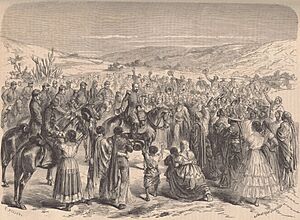
French General Bazaine occupied Guadalajara on January 5, 1864. Liberal generals Uraga and Ortega stayed nearby but didn't attack. After French attacks, González Ortega retreated.
Mexican General Felipe Navarrete of Yucatán supported the Empire. He invaded and captured the state capital of Mérida with French help on January 22, 1864.
French General Douay and General Castagny headed north. They captured Aguascalientes and Zacatecas by February 7, 1864. Castagny stayed in Zacatecas, while Douay went to help Colonel Garnier in Guadalajara. On February 16, Castagny won a victory.
Imperialists struggled to hold on to the southern state of Chiapas. The nearby state capital of Tabasco, San Juan Bautista, was taken back by the Republicans on February 27. This success led to a Republican attack into Veracruz, capturing Minatitlán on March 28.
On March 19, 1864, Manuel Lozada, a commander in western Mexico, joined the imperialists. He led indigenous troops.
Douay went south, chasing Republican guerrilla leaders. He defeated one and destroyed two weapons factories. In March, Douay entered Colima.
Republican General Ortega and other guerrilla groups were pushed back. Manuel Doblado was defeated by Mejía when he tried to attack Monterrey. Doblado fled to the United States and died a year later. Napoleon III gave Mejía a special medal for his actions.
The Emperor and Empress of Mexico arrived in Veracruz in the summer of 1864. They were later crowned in the Cathedral of Mexico City.
Republican General Porfirio Díaz defeated imperialist commander Marcos Toledo at Taxco on October 26, 1864. Díaz then attacked a brigade in Iguala. But imperialist reinforcements forced him to stop. Díaz went south to his home state of Oaxaca and gathered more troops.
The Imperialists now controlled the central Mexican states. These areas had major cities, most of the population, rich mines, farms, and main centers for making and trading goods. The Republicans still controlled the less populated northern states. President Juárez led his government from Monterrey in the north. These northern states gave them money from Pacific ports. Weapons also came from California and Texas in the US.
The Republicans also held the southern states of Guerrero, Oaxaca, Tabasco, and Chiapas. Troops led by Porfirio Díaz held strong control there.
Northern and Southern Campaigns
The Imperialists now focused on taking the rest of the north. General Mejía led troops along the northern Gulf Coast. Other French forces supported him. The main base for this operation was in Querétaro.
On the Pacific Coast, a naval group was ready to work with Douay's troops. They planned to move north towards Sinaloa. They were helped by arguments among Republican military leaders. On September 26, 1864, the Imperialists captured the port of Bagdad. They now controlled every major port in the Gulf. The commander of troops at Bagdad, Juan Cortina, then switched sides to the Imperialists.
Santiago Vidaurri, the governor of Nuevo León and Coahuila, had disagreed with Juárez. Republican troops forced him into Texas. But troops loyal to Vidaurri stayed active. As Republican forces in the north were busy, Vidaurri's troops captured Monterrey on August 15, 1864. President Juárez barely escaped. Vidaurri then went to the capital and became an advisor to Emperor Maximilian. By the end of the year, the imperialists controlled Nuevo León and most of Coahuila.
On October 28, 1864, Imperialist Generals Leonardo Márquez and Douay attacked the army of Republican General Arteaga. They defeated them. A few days later, other Republican leaders were defeated near the US border. Márquez occupied Colima. By November 18, 1864, Márquez had captured the port of Manzanillo.
On November 12, 1864, a French naval group arrived at Mazatlán. They demanded the city surrender or they would bombard it. At the same time, the imperialist Manuel Lozada attacked the town by land. This led to a successful capture.
The imperialist Juan Vicario was pushed back when trying to reach Acapulco. The port then had to be left to the Republicans in December. French ships later recaptured Acapulco on September 11, 1864.
The Imperialists hoped to remove Porfirio Díaz from his stronghold in the south. They began to build roads. Towards the end of 1864, General Courtois d'Hurbal entered Oaxaca. Díaz was based in Oaxaca City with thousands of troops. He had turned the city into a fortified camp.
The French Commander in Chief, Bazaine, decided to lead the attack on Oaxaca City himself. By the end of January 1865, his forces numbered seven thousand men. The attack began on February 4. An all-out assault was planned for February 9. The large number of enemy troops caused panic among Díaz's men. Díaz didn't want to fight a hopeless battle and surrendered. Díaz was sent to Puebla and imprisoned. However, he escaped seven months later. He then raised a new army in the southern state of Guerrero.
The Empire's Decline
The end of the American Civil War in April 1865 changed everything for the French intervention. US President Abraham Lincoln never recognized Emperor Maximilian's government. But he couldn't help the Mexican Republicans until his own Civil War ended. Mexican Republican commanders hoped that extra weapons and US troops would soon help them. Maximilian received a message from the liberal government. It advised him to leave Mexico while he still could. President Juárez was now sure he would win. He wrote that "the United States will never permit [Maximilian] to consolidate his power."
Fighting in the North and the "Black Decree"
Republicans gathered forces in the north. General Miguel Negrete captured Saltillo and Monterrey in early April. These cities had been left by the imperialists. Negrete moved towards Matamoros. He was joined by American volunteers and General Juan Cortina, who had switched back to the Republicans. They captured all the towns along the Rio Grande. They reached Matamoros but retreated when faced with General Tomás Mejía and his French reinforcements.
Republican Colonel Pedro José Méndez captured Ciudad Victoria on April 23. He then captured Ciudad Tula on June 4. This cut off communications to imperialist-held Tampico.
US army troops and ships gathered in Texas along the Rio Grande. This led to more imperialist troops along the border. But it also caused more guerrilla fighting in the southern states. Some imperial officials resigned. They couldn't govern or defend their areas without enough troops.
In August 1865, French troops were focused in the north. Sinaloa was left with only one regiment. Republican General Antonio Rosales was killed trying to retake Álamos. But General Corona pushed the French troops back to Mazatlán.
After Negrete's defeat, General Brincourt went towards Chihuahua with 2,500 men. He entered Chihuahua City, which was the temporary capital of the Mexican Republic, on August 15. He drove President Juárez out. But Bazaine ordered Brincourt to return to Durango within three weeks. Brincourt left on October 29.
On October 1, 1865, the Republican government got a loan of $30 million in New York. This showed that investors believed the Republic would win. Volunteers from the US were joining the Republicans. Juárez, now safe at El Paso del Norte on the US-Mexican border, believed US pressure could make France leave.
The Imperial government made a harsh change in how the war was fought. On October 2, 1865, Emperor Maximilian issued the "Black Decree." This decree stated: "The troops under your orders will take no prisoners. Every individual of whatever rank, taken with arms in his hands, shall be put to death. In the future, let there be no exchange of prisoners. Let our soldiers understand that they cannot surrender to such men. This is a death-struggle. On both sides it is only a question of killing or be killed." Lighter punishments were given for helping guerrillas. Exceptions were made for those forced into service.
On October 13, Imperialist Colonel Ramón Méndez won a victory. He captured Republican generals Arteaga and Salazar. Méndez used the new Black Decree to execute both of them.
Mariano Escobedo tried to take Matamoros on October 25. Imperialist commander Tomás Mejía hesitated to attack. This was because of nearby US troops who supported the Republicans. French reinforcements arrived and scattered Escobedo's forces on November 8.
After staying at El Paso del Norte, Juárez returned to Chihuahua City on November 20. Maximilian convinced Bazaine to keep Chihuahua. An expedition of 500 troops went to the city. Juárez was forced to leave again on December 9 and fled to the US border.
Escobedo then captured Monterrey. But some imperial forces stayed in the citadel. General Pierre Joseph Jeanningros arrived with reinforcements on November 25. The imperialists then recaptured Monterrey.
General Mejía and French naval commander protested to the United States. They complained about the aid being given to the Republicans. But the US commander replied that those troops were no longer part of the US military. In January 1866, American troops raided Bagdad. This was a clear violation of neutrality. The US government removed the commander and punished those involved. This raid made the French cautious. They avoided fighting near the border. Instead, they focused on holding strong positions and keeping communications open with French-held ports.
France Announces Troop Withdrawal
In January 1866, Napoleon III announced that he would pull French troops out of Mexico. The US Secretary of State, William H. Seward, said that the French withdrawal should happen without any conditions. Napoleon promised the American government that the withdrawal would happen. He planned to remove troops in phases, starting in November 1866 and ending in November 1867. Seward then asked France to stop sending more troops to Mexico. He also asked Austria to stop recruiting volunteers. Both France and Austria agreed.
More Northern Retreats
French troops left Chihuahua on January 31, 1866. They left the city to their Native American allies. But Republican troops took it in March. Maximilian ordered Bazaine to retake Chihuahua in May. A new expedition was prepared. But new orders from France to withdraw troops stopped the plan.
French troops left Durango by November. This led to the Republicans taking back the province. Juárez moved his government south to Durango on December 26, 1866.
In the northwest, the French were mostly stuck in the ports of Guaymas and Mazatlán. Imperial General Edvard Emile Langberg held positions inland with the help of Native Americans. Álamos was captured by Republican general Ángel Martínez. He punished the Native American tribes that had helped the Empire. He then took back Hermosillo on May 4, only to lose it the next day. The French left Guaymas in September. Around the same time, Langberg was killed in a battle that led Republicans to take Ures.
Sonora then fell to the Republicans. Hundreds of people fled to the United States or tried to retreat with the French. Imperialist commanders were captured and shot with their families by the Republicans.
Southern Defeats
In July 1865, Arteaga advanced towards Tacámbaro. He was defeated by Lieutenant Colonel Van der Smissen.
In Michoacan, Republican forces were repeatedly pushed back. But in May 1866, they started fighting again. Acapulco was held by Imperialist General Montenegro. But his troops were weakened by sickness and desertion.
After Republican general Porfirio Díaz escaped, he went to Oaxaca. He hoped to form a new army. Díaz began to attack this territory in the Spring of 1866. He tried to cut off communications between Oaxaca and Puebla. Díaz took Teotitlan in August 1866. In early October, Díaz defeated an imperialist general. Díaz then began a siege of Oaxaca City. He lifted the siege for a few days to fight Austro-Mexican reinforcements, which he defeated. He then captured Oaxaca City on November 1, 1866. From there, he completed the capture of Oaxaca and advanced into Puebla.
Defeats on the Northern Gulf Coast
In the northeast, Republican forces blocked the route to Tampico. Other Republican generals were active in the region. After a Republican attack, an imperialist commander reinstalled the imperialist prefect. He then attacked the liberals but was defeated and captured. The Republicans did not immediately take the town, but the French withdrawal allowed them to take it in June 1866.
At Charco Escondido, Mejía was struggling against Republicans. Their forces were growing with American soldiers. He received reinforcements in April. Another group of reinforcements was surrounded and defeated by Republican troops near Camargo. Mejía was left with 500 men. He eventually retreated with all his men to Veracruz on June 23.
In November 1866, Matamoros fell to the Republicans with help from US troops. On November 9, imperialist Generals Márquez and Miramón returned from Europe to help. By the end of November, the French withdrawal meant the Republicans had taken back the North and West of the country.
On November 13, 1866, the French finished leaving Mazatlán. The former imperialist General Lozada then declared his neutrality.
A Republican commander who had attacked communications was killed near Tampico. However, because of the French withdrawal, Republican General Aureliano Rivera captured Tampico in May. The French held the port but surrendered in July. In August, they surrendered Tuxpan. Veracruz was now the only gulf port left under imperialist control.
Monterrey was left by the Imperialists on July 25, 1865, and Saltillo on August 4.
French General Douay left Matehuala on October 28. This was the northernmost imperialist post. Troops were left in San Luis Potosí under Mejía. But the small chance of victory made them retreat on Christmas Eve.
Central Mexico Becomes Vulnerable
Veracruz and the roads leading to it had been attacked by Republicans since early 1866. This was when the French withdrawal began. There was an Imperialist victory, but by August, other towns were surrendered to the Republicans. A Republican revolt had been crushed, but with Republican successes further north, it rose up again. They captured Jalapa in November. Pachuca was captured by Republicans in November, and Perote fell in January 1867.
The capital itself became vulnerable in late 1866. Towns near Mexico City were raided in October and December. Raiders attacked imperial soldiers and refugees heading towards Vera Cruz. An Imperialist commander had retreated after a defeat. Republican generals moved to occupy the Lerma Valley.
Guadalajara was left by the French on December 12, 1866. Imperial forces were left under General Gutiérrez. The imperialists left the city on December 19 and headed for Guanajuato. The former imperial commander Lozada declared his area neutral.
Final French Departures
On December 19, 1866, Napoleon III announced that all troops would be withdrawn sooner than planned.
In late December, the French left Guanajuato. They met up in Querétaro with retreating troops from San Luis Potosí. Then they headed towards the port of Vera Cruz. However, an imperialist group under Mejía stayed in Guanajuato. They held their position and kept Republican troops away.
Bazaine left Mexico City on February 5, 1867. Vera Cruz was left in charge of the imperial general Pérez Gómez. Vera Cruz was very busy with many ships helping the evacuation. Bazaine and the last of the French troops left for France on March 12.
Republican Victory
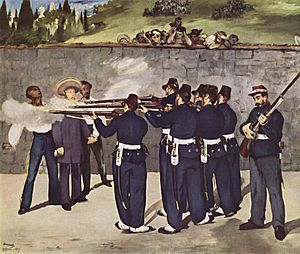
With the French officially gone, the intervention was technically over. But the Empire that French troops had set up lasted a few more months. The same Mexican generals who fought with the French continued to lead. Hundreds of Frenchmen also stayed as mercenaries.
After a meeting, Emperor Maximilian decided not to give up his throne. He planned to return to Mexico City. He stayed in Puebla for almost three weeks, preparing for the fight. The country was divided into three military areas. Miramón took command of the western area. Mejía led nearly 4,000 men in the east. Márquez, controlling the center, had 4,000 men. Maximilian took supreme command. He ordered the creation of a new national army and militia.
Unfortunately for the Empire, the Western and Eastern military areas were already controlled by the Republicans. The few remaining central areas were full of enemy groups. Funds and resources were also very low. Meanwhile, weapons and money from the United States were pouring into the hands of the Republicans.
On January 27, 1867, Miramón captured Aguascalientes. He almost captured President Juárez, but the governor helped Juárez escape. Miramón did not go further. He was happy with taking money and distracting the Republicans. He then joined Castillo at San Luis Potosí. Republican general Mariano Escobedo figured out his plans. He stopped him on February 1, leading to a complete defeat. Miramón escaped and hid in Querétaro. The Republicans had by then captured Guanajuato and Morelia. The Imperialists retreated to Querétaro.
The Siege of Querétaro
Maximilian joined the army at Querétaro. He brought money and 1,600 men with cannons. Maximilian arrived in Querétaro on February 19. Miramón and other generals welcomed him.
A few days later, a review of the troops showed 9,000 men with 39 cannons. This included about 600 Frenchmen. Miramón was put in charge of the infantry. Mejía became the head of the cavalry. Márquez was the chief of staff. Maximilian, Miramón, Márquez, Mejía, and Méndez became known as the "five magic M's" of the Empire.
In the first war meeting on February 22, they agreed to fight the Republicans right away. This was before the Republican forces became too strong. But this plan was rejected. As the Republicans surrounded Querétaro, Márquez suggested retreating to Mexico City. He wanted to gather forces there for one final battle. But this was not seen as practical.
On March 5, Republican forces appeared at Querétaro. They began to prepare for a siege. After the fighting started, Márquez again suggested retreating to Mexico City. But Miramón and others strongly opposed it. Miramón planned a counterattack for March 17. But a false alarm made them delay the attack.
Miramón now supported a plan to destroy the Republican positions in the west. This would provide a way to retreat if needed. Márquez was sent to Mexico City to get more soldiers. Miramón was to create a distraction. On March 22, he led an attack that captured supplies. Márquez was able to leave during the night with 1,200 horsemen. Miramón then became the main general at Querétaro.
The Imperialists pushed back another Republican attack. Miramón, during an award ceremony, decorated the Emperor for his bravery. Maximilian accepted it and wore it as his most valued medal.
On April 1, Miramón led a counterattack. But a lack of reinforcements meant it didn't have a big impact.
No news came from Márquez. A mission was sent to Mexico City to find out what happened. Miramón urged Maximilian to leave, but the emperor chose to stay. The mission failed. Leading officers now openly suggested surrendering.
The Imperialists planned to fight their way out of Querétaro. Miramón planned an attack on April 27. The Imperialists pushed back the Republican forces, taking 500 prisoners. But the Imperialists wasted time planning their next move. Republican reserves arrived and defeated them.
The Imperialists now wanted to break through enemy lines. They hoped to find safety in the mountains and reach the coast. This operation was planned for May 15.
Unfortunately for the Imperialists, their plans were betrayed by Colonel Miguel López. On the night of May 14, he opened the gates of Querétaro to the Republican forces for money. Republican troops quickly took over the city. Miramón, Mejía, and Emperor Maximilian were captured.
The End of the Empire and Maximilian's Execution
After a trial, Maximilian was sentenced to death. Many leaders in Europe and other important people asked Mexico to spare Maximilian's life. But Juárez refused. He believed he had to send a strong message. Mexico would not allow any government forced on it by foreign powers.
Maximilian was executed on June 19, 1867. His generals Miguel Miramón and Tomás Mejía were also executed. This happened on a hill outside Querétaro. Forces loyal to President Benito Juárez carried out the executions. Mexico City surrendered the day after Maximilian was executed.
The republic was restored. President Juárez returned to power in the capital. He made few changes to policy. This was because Maximilian had actually kept most of Juárez's liberal reforms.
After the victory, the Conservative party was so discredited by its alliance with the French that it almost disappeared. The Liberal party was mostly unopposed for several years. In 1871, Juárez was re-elected president. This was despite a rule against re-elections. The French intervention ended with a more stable Republican government.
Porfirio Díaz, a Liberal general and war hero, launched a rebellion against Juárez. This revolt was failing when Juárez died in 1872. Díaz ran against the new president, but lost. Four years later, in 1876, Díaz launched a second, successful revolt. He captured the presidency. He held it for many years, a period known as the Porfiriato. After many civil wars, Mexico finally had a period of peace under Díaz.
France's adventure in Mexico improved relations with Austria. But it didn't help France politically in the world. In 1866, Prussia went to war with Austria. Austria was quickly defeated while French troops were still in Mexico. Napoleon's empire would later fall in 1870 during the Franco-Prussian War.
US Diplomacy and Involvement
As early as 1859, the US and Mexico tried to approve a treaty. This treaty would have allowed the US to build in Mexico and protect it from European forces. In exchange, the US would pay Mexico $4 million. But the US Senate was divided over slavery issues, and the treaty failed. On December 3, 1860, President James Buchanan said he was unhappy about not being able to protect Mexico from European interference.
United States policy did not change during the French occupation. The US had to use its resources for the American Civil War, which lasted from 1861 to 1865. President Abraham Lincoln expressed his support for Latin American republics against any European attempt to set up a monarchy. Shortly after the imperial government was established in April 1864, US Secretary of State William H. Seward said the US was uncomfortable with a monarchy in Mexico. He stated that the US's safety depended on free republican governments in America.
On April 4, 1864, Congress passed a resolution. It stated that the US was not indifferent to the events in Mexico. It declared that it was against US policy to recognize a monarchy set up by a European power in America.
Near the end of the American Civil War, leaders discussed a plan for North-South peace. This plan involved joint action against the French in Mexico. In 1865, the Juárez government raised money by selling Mexican bonds in the US. They got between $16 million and $18 million to buy American war supplies. Between 1865 and 1868, General Herman Sturm helped deliver guns and ammunition to Juárez's Republican forces. In 1866, General Philip Sheridan was in charge of sending more supplies and weapons. This included 30,000 rifles from a US arsenal.
By 1867, Seward changed US policy. It went from quiet support for Juárez to open threats of war. This was to make France leave. Seward used the Monroe Doctrine. He later said in 1868, "The Monroe Doctrine, which eight years ago was merely a theory, is now an irreversible fact."
Images for kids
-
Uniforms of officers and soldiers of the Belgian regiment: bodyguards of the Empress Charlotte.


